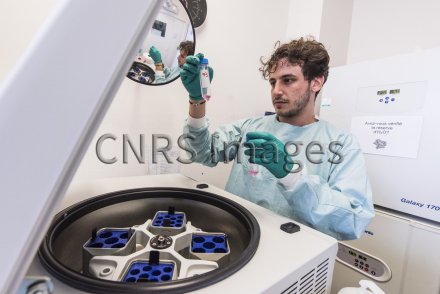Production year
2017

© Hubert RAGUET / Institut Cochin / CNRS Images
20170080_0021
Placing a culture of purified human monocytes from peripheral blood into a centrifuge. These cells will then be differentiated into Langerhans cells, a subpopulation of dendritic cells that presents antigens found in stratified mucosa such as the foreskin or vagina. They will then be infected with HIV or the herpes virus in the laboratory so that they can be used in tests aiming to analyse the molecular mechanisms of infection. Langerhans cells are produced in the laboratory as they are difficult to obtain from tissue, where they are fairly rare. HIV is chiefly transmitted via the genital mucosa during unprotected sexual intercourse. Although the mechanisms through which the virus enters via the female genital mucosa are fairly well understood, much less is known about the way in which the virus enters via the male genital mucosa. That said, epidemiological studies have demonstrated that circumcision is 50 to 70% effective in protecting men from sexually transmitted infection. The "Mucosal entry of HIV and mucosal immunity" team led by Morgane Bomsel has shown that the virus can effectively penetrate the internal surface of the foreskin and rapidly target Langerhans cells, which are antigen-presenting cells that monitor mucosae such as the foreskin. In addition, the mucosae are innervated by peripheral neurons that innervate all mucosae, including the foreskin. These neurons secrete neuropeptides locally following so-called "harmful" stimulation such as heat produced by rubbing. The scientists in the team have demonstrated that one of these locally secreted neuropeptides, calcitonin gene-related peptide (CGRP), blocks HIV from entering mucosae such as the foreskin by stopping it entering the Langerhans cells. This mechanism may also apply to other viruses such as that for genital herpes (HSV), and have consequences for the dynamics of HIV-HSV coinfections. CGRP could therefore serve as a potential natural microbicide.
The use of media visible on the CNRS Images Platform can be granted on request. Any reproduction or representation is forbidden without prior authorization from CNRS Images (except for resources under Creative Commons license).
No modification of an image may be made without the prior consent of CNRS Images.
No use of an image for advertising purposes or distribution to a third party may be made without the prior agreement of CNRS Images.
For more information, please consult our general conditions
2017
Our work is guided by the way scientists question the world around them and we translate their research into images to help people to understand the world better and to awaken their curiosity and wonderment.